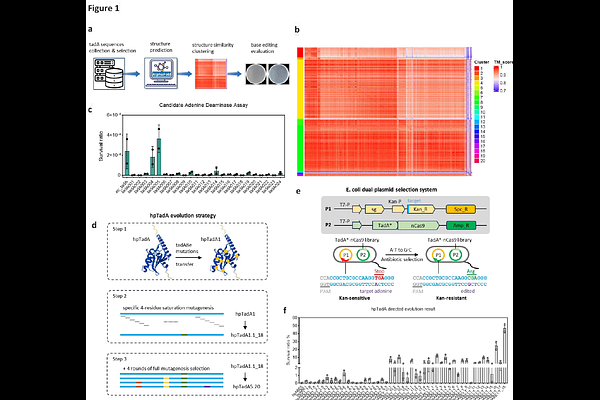Sequential Amino Acid Mutagenesis-Driven De Novo Evolution of Adenine Deaminases Enables Efficient In Vivo Base Editing in Primate

Sequential Amino Acid Mutagenesis-Driven De Novo Evolution of Adenine Deaminases Enables Efficient In Vivo Base Editing in Primate
Liao, J.; Zhang, H.; Chen, S.; Hsiao, S.; Lai, C.; Feng, H.; Ren, W.; Feng, C.; Xie, D.; Zheng, Y.; Cai, W.; Wang, W.; Jiang, Y.; Wang, D.; Zuo, E.; Wang, Z. J.; Lu, Y.; Wu, Y.
AbstractBase editing allows for the precise modification of genetic information, providing new avenues for treating diseases1. The adenine base editor ABE8e is currently the most efficient and widely used tool for adenine base editing. ABE8e was developed through multiple rounds of directed evolution of Escherichia coli tRNA adenine deaminase, including phage-assisted continuous evolution (PACE)2,3. While PACE is highly effective, it is a complex system that poses challenges for implementation4. Despite its high efficiency, ABE8e is associated with limitations such as relatively higher bystander editing effects and elevated off-target activity5, which need to be addressed to further enhance its precision and safety. Here, we developed a novel method for the de novo discovery of evolved ABE components, particularly adenine deaminases. This process involves identifying candidate proteins through AI-based structural prediction and clustering, followed by the enhancement of deaminase editing activity through screening libraries created by sequential amino acid saturation mutagenesis. This evolutionary strategy simplifies the approach by employing saturation mutagenesis libraries tailored to specific segments, thereby enabling exploration of an expanded sequence space and increasing the likelihood of discovering adenine deaminases with superior capabilities. The newly developed hpABE5.20 here demonstrates a more refined editing window, reduced DNA off-target effects that are both sgRNA-dependent and -independent, and minimized RNA off-target activity, while maintaining robust editing efficiency relative to ABE8e. Furthermore, hpABE5.20 has been successfully applied for precise and effective therapeutic adenine base editing in cellular disease models, humanized mice, and non-human primates.